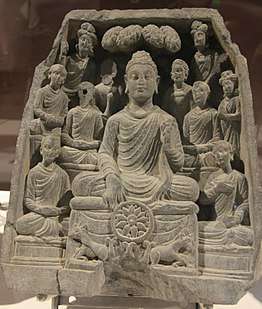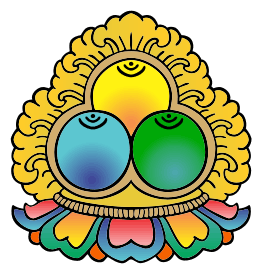Refuge (Buddhism)

| Part of a series on |
| Buddhism |
|---|
 |
|
| Translations of Refuge (Buddhism) | |
|---|---|
| Pali | saraṇa (सरण) |
| Sanskrit | śaraṇa (शरण) |
| Bengali |
শরন (Shôrôn) |
| Chinese |
皈依 (Pinyin: Guīyī) |
| Japanese |
帰依 (rōmaji: kie) |
| Korean |
귀의 (RR: gwiui) |
| Thai |
สรณะ, ที่พึ่ง ที่ระลึก RTGS: sarana, thi phueng thi raluek |
| Vietnamese | Quy y |
| Glossary of Buddhism | |
Buddhists take refuge in the Three Jewels or Triple Gem (also known as the "Three Refuges").
The Three Jewels are:
- the Buddha, the fully enlightened one
- the Dharma, the teachings expounded by the Buddha
- the Sangha, the monastic order of Buddhism that practice the Dharma
Refuge is common to all major schools of Buddhism. Pali texts employ the Brahmanical motif of a group of three refuges, as found in Rig Veda 9.97.47, Rig Veda 6.46.9 and Chandogya Upanishad 2.22.3-4.[1]
Faith (saddha)
Faith is an important teaching element in both Theravada and Mahayana traditions. In contrast to perceived Western notions of faith, faith in Buddhism arises from accumulated experience and reasoning.
In the Kalama Sutra, the Buddha explicitly argues against simply following authority or tradition, particularly those of religions contemporary to the Buddha's time.[2] There remains value for a degree of trusting confidence and belief in Buddhism, primarily in the spiritual attainment and salvation or enlightenment. Faith in Buddhism centres on belief in the Three Jewels.
Precepts
For someone who wishes to study and practice Buddhism, the five ethical precepts encouraged are to voluntarily undertake the practice to:[3]
- refrain from killing.[4][5][6]
- refrain from stealing.[4][5][6]
- refrain from lying.[4][5][6]
- refrain from improper sexual conduct.[4][5][6]
- refrain from consuming intoxicants.[4][5][6]
For those interested in slightly more advanced practices, on full moon, new moon, and sometimes other quarter moon days, it is encouraged to undertake the eight ethical precepts, which also includes:
Three Roots

In Tibetan Buddhism there are three refuge formulations, the Outer, Inner, and Secret forms of the Three Jewels. The 'Outer' form is the 'Triple Gem', (Sanskrit:triratna), the 'Inner' is the Three Roots and the 'Secret' form is the 'Three Bodies' or trikaya of a Buddha. These alternative refuge formulations are employed by those undertaking Deity Yoga and other tantric practices within the Tibetan Buddhist Vajrayana tradition as a means of recognizing Buddha Nature.
| Tibetan Buddhist Refuge Formulations | |||
| Outer or 'Three Jewels' | Buddha | Dharma | Sangha |
| Inner or 'Three Roots' | Lama (Guru) | Yidam (Ista-devata) | Khandroma (Dakini)[7] |
| Secret or 'Trikaya' | Dharmakaya | Sambhogakaya | Nirmanakaya |
| Three Vajras | Mind | Speech | Body |
| seed syllable | blue hum | red ah | white om |
Three refuge motivation levels are: 1) suffering rebirth's fear motivates with the idea of happiness, 2) knowing rebirth won’t bring freedoms motivates attaining nirvana, while 3) seeing other’s suffering motivates establishing them all in Buddhahood.[8] Happiness is temporary, lifetimes are impermanent and ultimately refuge is taken until reaching unsurpassed awakening.[9]
See also
Notes
- ↑ Shults, Brett (May 2014). "On the Buddha's Use of Some Brahmanical Motifs in Pali Texts". Journal of the Oxford Centre for Buddhist Studies. 6: 119.
- ↑ "Kalama Sutta: The Buddha's Charter of Free Inquiry". 4 February 2013. Archived from the original on 4 February 2013.
- ↑ The precepts may be listed in order of the gravity of harmful actions guarded against. Improper sexual conduct can roughly mean 'hurtful or harmful' sexual conduct.
- 1 2 3 4 5 6 7 8 "The Eight Precepts: attha-sila". www.accesstoinsight.org.
- 1 2 3 4 5 6 7 8 "Uposatha Sila: The Eight-Precept Observance". www.accesstoinsight.org.
- 1 2 3 4 5 6 7 8 Sāmi, Dhamma. "The 8 precepts". en.dhammadana.org.
- ↑ In Sarma traditions, this root is the Chokyong (Skt: dharmapāla, Wylie: chos-kyong)
- ↑ Rinpoche, Patrul. Words of My Perfect Teacher: A Complete Translation of a Classic Introduction to Tibetan Buddhism (Sacred Literature) (2011 ed.). Yale University Press. pp. 176–177. ISBN 0-300-16532-3.
- ↑ Dorje, Choying Tobden; Zangpo, Ngawang (June 2, 2015). The Complete Nyingma Tradition from Sutra to Tantra, Books 1 to 10: Foundations of the Buddhist Path (First ed.). Snow Lion. pp. 224–227. ISBN 1-55939-435-8.
References
- Sangharakshita, Going for Refuge. Windhorse Publications. (1997)
External links
- A Buddhist View on Refuge
- Refuge: A Safe and Meaningful Direction in Life by Dr. Alexander Berzin
- Refuge Vows (including commentary by Dr. Alexander Berzin)
- Taking the refuges and precepts online by Bhikkhu Samahita
- Vajrayana refuge prayer audio
- The Threefold Refuge (tisarana)
- Five Precepts (pañca-sila)
- Abhisanda Sutta (Anguttara Nikaya)
- Saranagamana (Khuddakapatha)
- Going for Refuge and Taking the Precepts by Bhikkhu Bodhi
- Refuge: An Introduction to the Buddha, Dhamma and Sangha by Thanissaro Bhikkhu
- Refuge Tree Thangkas by Dharmapala Thangka Centre
- Ceremony for Taking Refuge and Precepts by Ven. Thubten Chodron